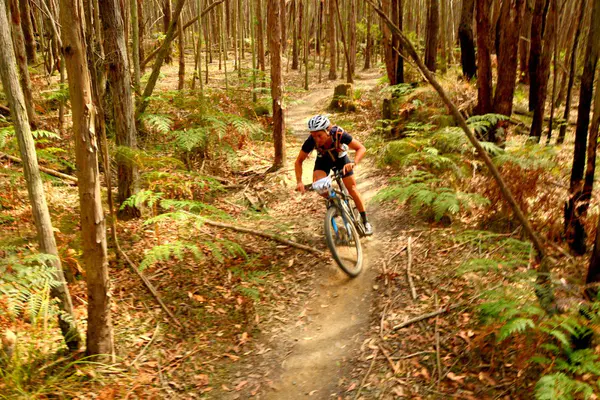Mountain biking is an exhilarating sport. It allows riders to explore nature, challenge themselves, and enjoy the thrill of off-road cycling. Among the various terms used in mountain biking, “singletrack” is one of the most important. This article will delve into the meaning of singletrack, its significance in mountain biking, and everything related to this popular trail type.
Definition of Singletrack
Singletrack is a type of mountain biking trail. As the name suggests, it is narrow and usually allows for only one bike to pass at a time. Singletrack trails are typically about the width of a bike, roughly 18 to 24 inches. These trails wind through forests, hills, and mountains, offering an immersive experience for mountain bikers.
History of Singletrack
Singletrack trails have a rich history. They originated from hiking paths and animal trails that were later adopted by mountain bikers. In the early days of mountain biking, riders would explore these existing trails. Over time, dedicated singletrack trails were developed specifically for mountain biking. This evolution has led to the creation of some of the most exciting and challenging trails in the world.
Characteristics of Singletrack
Singletrack trails vary greatly in terms of difficulty, terrain, and design. Here are some common characteristics:
- Narrow Width: Singletrack trails are typically narrow, allowing only one bike to pass at a time.
- Winding Paths: These trails often wind through natural landscapes, including forests, mountains, and valleys.
- Varied Terrain: Singletrack can include a variety of terrains such as dirt, rocks, roots, and even man-made features.
- Elevation Changes: Many singletrack trails have significant elevation changes, adding to the challenge and excitement.
- Technical Sections: Singletrack often includes technical sections that require advanced riding skills.
Types of Singletrack Trails
There are several types of singletrack trails, each offering a unique riding experience:
- Flow Trails: These are designed for smooth, fast riding with gentle curves and minimal obstacles.
- Technical Trails: These trails include challenging features such as rocks, roots, and steep climbs or descents.
- Cross-Country Trails: These are typically longer trails that focus on endurance and include a mix of terrain types.
- Downhill Trails: These are steep trails designed for fast descents, often with jumps and drops.
Building and Maintaining Singletrack
Building singletrack trails requires careful planning and construction. Here are some key steps involved:
- Trail Design: Planning the route to minimize environmental impact and maximize rider enjoyment.
- Clearing the Path: Removing vegetation and obstacles to create a clear trail.
- Shaping the Trail: Creating the trail surface, including smoothing out bumps and creating berms or jumps.
- Sustainable Practices: Using techniques to prevent erosion and maintain the trail over time.
The Experience of Riding Singletrack
Riding singletrack is a unique experience. The narrow trails require precise handling and concentration. Here are some aspects that make singletrack riding special:
- Connection with Nature: Singletrack trails often take riders through beautiful natural settings.
- Challenge and Skill: The technical nature of singletrack requires advanced riding skills and offers a rewarding challenge.
- Variety and Adventure: No two singletrack trails are the same, providing endless opportunities for exploration and adventure.
Tips for Riding Singletrack
For those new to singletrack, here are some tips to get started:
- Start Slow: Begin with easier trails to build confidence and skill.
- Stay Focused: Pay attention to the trail ahead and be prepared for sudden changes.
- Use Proper Gear: Ensure your bike is suitable for singletrack and wear appropriate protective gear.
- Respect the Trail: Follow trail etiquette and leave no trace to preserve the trails for others.
The Community of Singletrack Riders
Singletrack riding has a vibrant and supportive community. Riders often share tips, organize group rides, and work together to maintain trails. Joining a local mountain biking club can be a great way to connect with other singletrack enthusiasts.
Conclusion
Singletrack is an integral part of mountain biking. Its narrow, winding paths offer a unique and thrilling experience for riders of all skill levels. Whether you’re a seasoned rider or just starting, singletrack trails provide endless opportunities for adventure and connection with nature.
See Also: How to Gain Confidence Mountain Biking
FAQ: What Does Singletrack Mean in Mountain Biking?
Q: What is singletrack?
A: Singletrack refers to a narrow trail that is only wide enough for one mountain biker at a time. It is typically found in forests or other natural environments and is used for mountain biking.
Q: Why is it called singletrack?
A: The term “singletrack” comes from the fact that the trail is only wide enough for a single bike tire, making it necessary for riders to ride single file.
Q: Is singletrack always flat?
A: No, singletrack can be flat, uphill, downhill, or have any combination of terrain. It is often characterized by its narrowness rather than its gradient.
Q: Are there different types of singletrack?
A: Yes, there are different types of singletrack based on the terrain and difficulty level. Some may be smooth and flowy, while others may be rocky and technical.
Q: How do I know if a trail is singletrack?
A: Look for signs of a narrow trail with minimal space for passing. You may also see markers indicating the trail’s width or difficulty level.
Q: Can I ride my mountain bike on any singletrack trail?
A: It depends on the trail’s rules and regulations. Some trails may be designated for hiking only, while others may allow mountain biking. Always check before riding.
Q: How do I stay safe on singletrack trails?
A: Wear protective gear, such as a helmet and gloves, and be aware of your surroundings. Stay alert for obstacles and other riders, and communicate with those around you.
Q: How do I improve my skills on singletrack trails?
A: Practice riding on different types of singletrack trails to challenge yourself and build your skills. Consider taking lessons from a certified instructor or joining a local mountain biking group.

